 2 goodness-of-fit from
profile-fit photometry < 10 in at least one band
(to reject residual cosmic rays and meteor trail detections)
2 goodness-of-fit from
profile-fit photometry < 10 in at least one band
(to reject residual cosmic rays and meteor trail detections)The Second Incremental Release PSC was drawn from a database of all detections found in the 27,493 Tiles included in the release area. This Working Database contains approximately a factor of two more objects than are in the PSC, and a large number are simply detections of noise. The source detection thresholds in 2MASS pipeline data processing are set intentionally low to insure completeness. A rigorous set of selection criteria, described in detail in Section V.3, are applied to each source in the working database to extract a set of Catalog sources that meet the demanding reliability requirements of 2MASS:
 2 goodness-of-fit from
profile-fit photometry < 10 in at least one band
(to reject residual cosmic rays and meteor trail detections)
2 goodness-of-fit from
profile-fit photometry < 10 in at least one band
(to reject residual cosmic rays and meteor trail detections)Users are recommended to review the Cautionary Notes for the PSC in Section I.6.b for known features of and problems in the Catalog.
Figure 1 shows a map of average PSC source density in 5´ × 5´ bins in a galactic aitoff projection, with an equatorial coordinate grid overlaid. The enhancement of source density in the galactic plane is obvious. The following table and Figure 2 give the fractional distribution of sources in the Second Incremental Release with galactic latitude. The counts are not normalized to area, though, so do not represent the mean density of sources on the sky. Still, it is obvious that the majority of point sources will be heavily concentrated towards the Galactic plane; 77% of the PSC objects have |b| < 20o. See Section VI.5 for a description of source density, integrated source counts vs. magnitude, and other properties of the Catalog in representative regions of the sky.
The differential J, H and Ks PSC source counts, normalized by area, measured in 2° diameter circular fields at the north galactic pole, at b = -30°, and at two locations on the galactic plane, l = 245° and l =55° are shown in Figures 3, 4, 5, and 6, respectively. In each figure, the blue line represents the J-band source density, the green line is H and the red line is Ks. At high latitude, the 2MASS PSC contains accurate detections 0.5-1.0 magnitudes fainter than the nominal Survey completeness limits of J=15.8, H=15.1 and Ks=14.3 mag. The turnover in the measured source density in the Galactic plane fields occurs nearly 1 magnitude brighter than the higher latitude fields because of the affects of confusion noise on the detection thresholds. The low galactic latitude plots also shows a number of unphysically faint sources in each band. These measurements are all accompanied by large uncertainties and low SNR's, and are of correspondingly low confidence.
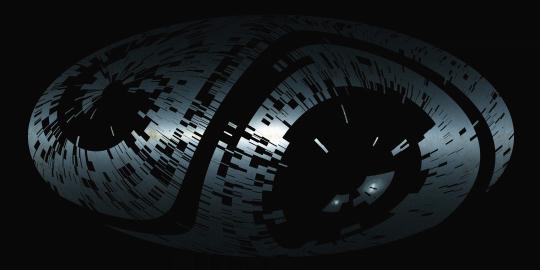
|
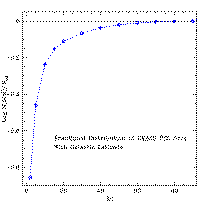 |
| Figure 1 | Figure 2 |

|

|

|
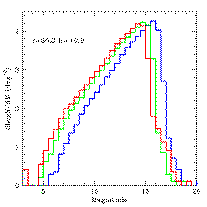 |
| Figure 3 | Figure 4 | Figure 5 | Figure 6 |
The characteristic photometric precision of measurements of unconfused sources in the 2MASS PSC is illustrated by Figure 7 which shows the photometric repeatability for point sources in the P161-D calibration field. The black crosses represent the RMS dispersion about the mean magnitude plotted vs. the mean magnitude of all sources detected at least 16 out of the 18 times the field was observed during the night of 16 November 1997 UT. Red points denote sources detected fewer than 16 out of 18 times. The green bars indicate the mean RMS averaged in 0.5-mag bins. The top panel shows data for the J-band; H-band is in the center panel; and, Ks is in the bottom panel. The horizontal blue lines indicate the SNR=10 level, and the vertical blue lines indicate the Level 1 Requirement magnitudes for SNR>10. These data illustrate that the achieved SNR=10 levels in 2MASS are frequently fainter than those specified in the requirements in all three bands.
The J-H-Ks Color-Color Diagram for the same four fields described in Figures 3-6 are shown in Figures 8, 9, 10, and 11, respectively. In these figures, yellow points indicate sources with SNR(Ks)>40, blue points have SNR(Ks)>20 and black points have SNR(Ks)<20). The red and green lines indicate dwarf and giant tracks, respectively, from Koorneef (1983, A&A, 129, 84) and Bessell and Brett (1988, PASP, 100, 1134). The diagonal black line indicates the reddening vector for AV=5 mags. Significant reddening is apparent only in the l =55°, b =+1° field. Confusion in high source density regions contributes to the large scatter in the colors of the low SNR sources.
 |
| Figure 7 |
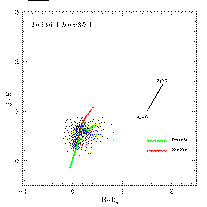
|

|

|
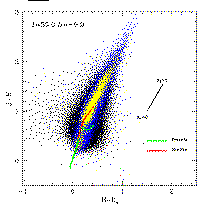 |
| Figure 8 | Figure 9 | Figure 10 | Figure 11 |
The internal RA (top) and DEC (bottom) positional repeatability of all sources in the P161-D calibration field observed on 16 November 1997 UT are shown in Figure 12 vs. Ks magnitude. As in Figure 7, the black crosses denote sources detected at least 16 out of the 18 times the field was scanned, red points indicate sources detected less than 16 times, and the green bars show the average positional RMS in 0.5-mag bins. The full scale in each panel is 0.5". One can see that the internal positional consistency is outstanding.
The distribution of Right Ascension and Declination residuals between the
reconstructed and ACT reference catalog
positions of approximately 358,000 ACT stars included in the Second Release
PSC are shown in Figure 13.
The 1- values for each distribution are
approximately 0.1´´.
Comparison of the positions of stars in the PSC with those in the
Tycho 2 and
UCAC
catalogs, which are not used in 2MASS position
reconstruction, indicates
that the astrometric accuracy of 2MASS is <0.2´´ (cf
VI.2).
values for each distribution are
approximately 0.1´´.
Comparison of the positions of stars in the PSC with those in the
Tycho 2 and
UCAC
catalogs, which are not used in 2MASS position
reconstruction, indicates
that the astrometric accuracy of 2MASS is <0.2´´ (cf
VI.2).
The 2MASS Second Release PSC contains 3325 sources that are positionally associated with the predicted positions of known minor planets, comets, planets and planetary satellites. A number of these objects appear in the PSC multiple times because they moved to a region of sky covered by observations of a different Tile at a different time. For example, (2060) Chiron appears in the PSC twice, its position having been scanned on 27 March 1998 and 23 April 1998 UT. Some fraction of the putative detections are not valid, but are chance superpositions of the objects on background sources. This is particularly likely at low Galactic latitudes where the density of background stars is large.

|
 |
| Figure 12 | Figure 13 |
[Last Updated: 2000 February 21, by R. Cutri]